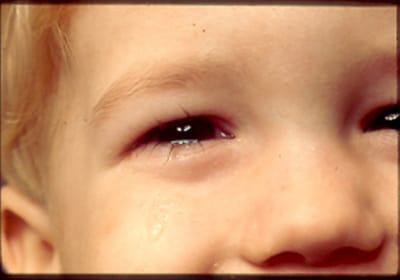Nasolacrimal-Duct

return to previous page
NASOLACRIMAL DUCT OBSTRUCTION
 |
|  NLD obstruction -epiphora
NLD obstruction -epiphoraNormal canalisation of the nasolacrimal ducts may nor occur until 4-6 months of age. Tear overflow and secondary infection may result from this obstruction. The nasolacrimal duct system drains excess tears from the eye into the nose. It consists of an opening-punctum, initial tube- canaliculus, a reservoir- lacrimal sac, final tube- nasolacrimal duct.The obstruction in infancy is in the duct. Tears stagnate in the sac and bacteria result in a muco-purulent discharge to be accumulate and overflow back into the conjunctival sac.
Clinical Findings
-watery, discharging eyes in first few months of life blocked tear duct
- overflow of tears
- no conjunctival redness
Different Diagnosis- acute conjunctivitis (red, discharging eye)
Management
- Reassure parents of natural history
- Massage over lacrimal sac
- Local antibiotic drops – for secondary infection
*If not resolved at 6 – 10 months of age the obstruction may be overcome by passing a fine probe through the tear passages, usually under a general anaesthetic.
Probing Tear Duct
*If performed prior to 12 months of age 95% are corrected with a single probing. after 12 months this decreases to 70%. By 2 years of age the cure rate has reduced further.
*Severe infection may prompt earlier intervention to prevent fibrosis and chronic occlusion, for this may require major surgical intervention. Infection in the tear sac may result in an abscess forming- acute dacryocystitis- requiring immediate treatment.
*If a probing does not improve the condition a silicone tube is placed in the nasolacrimal system for a number of weeks to maintain its patency. This procedure is more complex than a probing.



